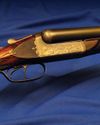Loss Of Sage In Great Basin Impacts Upland Bird Numbers
The Upland Almanac
|Summer 2017
One of the greatest upland bird hunting areas in the West, the Great Basin of Nevada and surrounding states, is in jeopardy of losing most of its sagebrush habitat and the wildlife populations that depend on sage for food and cover.

The loss of sage habitat has already cut the sage grouse population by around 15 percent, according to Shawn Espinoza, a wildlife biologist with the Nevada Division of Wildlife. While the big grouse depend on sage for food and cover, chukar, Hungarian partridge, Columbian sharp-tailed grouse and valley quail also rely on sage for protection from predators and as nesting cover. All upland bird species are negatively impacted by the loss of sage.
Wildfires and an invasive grass called cheat grass are the one-two punch driving the decline in sagebrush. The fires, which are increasing in size and intensity, now convert vast areas of sage and scrub into permanent grasslands, consisting of cheat grass and few other species. Cheat grass fuels those fires and has expanded its range and density with each burn, increasing the fire risk. It has become a vicious cycle.

A recent U.S. Geological paper examining the relationship between sage grouse and fires in sagebrush habitat projected that more than 50 percent of the sage grouse population is likely to disappear in the Great Basin over the next 25 years if the cycle isn’t broken or habitat restoration isn’t accelerated.
Jim Jeffress, a retired Nevada Division of Wildlife biologist who is now president of the Idaho Wild Sheep Foundation, said he “wouldn’t be a bit surprised if 60 to 70 percent of Wyoming (big) sage has been lost” already in the Great Basin.

Denne historien er fra Summer 2017-utgaven av The Upland Almanac.
Abonner på Magzter GOLD for å få tilgang til tusenvis av kuraterte premiumhistorier og over 9000 magasiner og aviser.
Allerede abonnent? Logg på
FLERE HISTORIER FRA The Upland Almanac

The Upland Almanac
The Land Moved
With a snap of his head, our springer spaniel Chip bolted into the underbrush.
7 mins
Autumn 2025

The Upland Almanac
Creating Habitat: Nature's Way
It’s a good bet that warm, cozy and secure in their homes throughout the land, most traveling bird hunters remained blissfully unaware of nature’s rampage in Michigan last spring.
4 mins
Autumn 2025

The Upland Almanac
Day Three: A Hunt Story, Sort Of
Sometimes the story of a day's hunt doesn't say much about shots fired or birds in the bag...
4 mins
Autumn 2025

The Upland Almanac
NIRVANA OR NOT IN THE NORTH WOODS
If there's one shrub in a favorite ruffed grouse covert that will dampen the excitement of a crisp, fall hunt, it's prickly ash.
3 mins
Autumn 2025

The Upland Almanac
George Bird Evans: The Artist Before the Author
It doesn’t take long for a person new to the sporting world before they encounter classic book titles such as The Upland Shooting Life, Troubles with Bird Dogs or An Affair with Grouse.
4 mins
Autumn 2025

The Upland Almanac
SOUTHERN SAFARI
GEORGIA BOBWHITES AT FISHING CREEK FARMS
7 mins
Autumn 2025

The Upland Almanac
Charles and His Remington: A Gentleman's Choice from America's Gun-Makers' Row - Remington Model 1884 EE Grade
A Civil War vet, let's call him Charles (pronounced with a snobbish lilt, of course), was thoroughly smitten by the parade of high-end American-made, side-by-side, hammerless “automatic” (ejector) shotguns emerging from America's esteemed “Gun-Makers Row”— New England, New York and Pennsylvania.
3 mins
Autumn 2025

The Upland Almanac
Profile of an Artist: Cindy Dalton
Art has always played a central role in Cindy Dalton's life.
2 mins
Autumn 2025

The Upland Almanac
Bird Camp Grouse with Mushrooms and Yorkshire Pudding
While visiting my wife's sister Lyndis at her tiny country cottage in Yorkshire, England, a few years ago, we were treated to a spectacular roast beef lunch that ranks as one of the most memorable meals I've ever eaten.
3 mins
Autumn 2025

The Upland Almanac
Field Foot Care and Dog Boots
A few years ago, I was chasing chukars in southern Idaho's cheatgrass and rimrock country.
4 mins
Autumn 2025
Translate
Change font size

